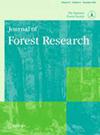不同更新方式对松林土壤呼吸的影响
IF 1.1
4区 农林科学
Q3 FORESTRY
引用次数: 0
摘要
森林更新过程中产生的非生物和生物因子的变化会对土壤呼吸产生重大影响,而土壤呼吸是森林碳循环的重要组成部分。本研究旨在测定在韩国松枯萎病(PWD)干扰林分中种植的圆柏再生方法引起的土壤呼吸速率。2007年,采用两种再生方法种植了四年生的C.obtusa幼苗,即清除受感染的松树(CS)或在受干扰的松林中选择性切割受感染的松木(DS)后进行底层种植。用两种再生方法和一个未受干扰的松树林(NS)对土壤呼吸速率进行了两年的评估。DS的平均土壤呼吸速率显著较低(1.07 µmol m−2 s−1)处理比NS(1.87 µmol m−2 s−1)处理,而CS之间没有显著差异(1.44 µmol m−2 s−1)处理和NS或DS处理。三种处理的土壤呼吸速率与土壤温度呈指数关系(R2 = 0.57–0.81)。CS的年土壤呼吸速率显著较高(6.49 Mg C ha−1年−1)比DS(3.98 Mg C ha−1年−1)治疗。DS(2.00–2.03)处理的Q 10值最低,其次是CS(2.23–2.62)和NS(2.74–3.07)处理。这些结果表明,PWD干扰林分的DS方法是降低土壤年呼吸率的关键驱动因素之一。本文章由计算机程序翻译,如有差异,请以英文原文为准。
Comparisons of different regeneration approaches on soil respiration of Chamaecyparis obtusa planted in pine wilt disease-disturbed stands
ABSTRACT Changes in the abiotic and biotic factors created by forest regeneration can have a major influence on soil respiration, which is an important component of the forest carbon (C) cycle. This study was performed to determine the soil respiration rates caused by regeneration approaches in Chamaecyparis obtusa planted in pine wilt disease (PWD)-disturbed stands in South Korea. In 2007, four-year-old C. obtusa seedlings were planted with two regeneration approaches, clearcutting (CS) of infected pine trees or underplanting following selective cutting (DS) of infected pine trees in disturbed pine stands. Soil respiration rates were assessed in two regeneration approaches and an undisturbed pine stand (NS) for two years. The mean soil respiration rates were significantly lower in the DS (1.07 µmol m−2 s−1) treatment than in the NS (1.87 µmol m−2 s−1) treatment, whereas there was no significant difference between the CS (1.44 µmol m−2 s−1) treatment and the NS or DS treatment. The three treatments showed exponential relationships between soil respiration rates and soil temperature (R 2 = 0.57–0.81). The annual soil respiration rates were significantly higher in the CS (6.49 Mg C ha−1 year−1) treatment than in the DS (3.98 Mg C ha−1 year−1) treatment. The Q 10 values were lowest in the DS (2.00–2.03) treatment, followed by the CS (2.23–2.62) and NS (2.74–3.07) treatments. These results reveal that DS approaches in PWD-disturbed stands are one for the critical drivers of reducing annual soil respiration rates.
求助全文
通过发布文献求助,成功后即可免费获取论文全文。
去求助
来源期刊

Journal of Forest Research
农林科学-林学
CiteScore
3.00
自引率
6.70%
发文量
62
审稿时长
3 months
期刊介绍:
Journal of Forest Research publishes original articles, reviews, and short communications. It covers all aspects of forest research, both basic and applied, with the aim of encouraging international communication between scientists in different fields who share a common interest in forest science.
 求助内容:
求助内容: 应助结果提醒方式:
应助结果提醒方式:


